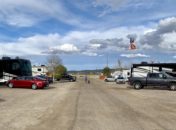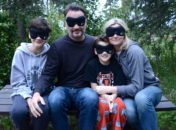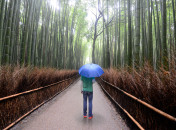Technically it was still summer, August 28th, and the sky harbored a bright and shiny sun. But the air smelled like fall. The hosts at the Hildibrand Hotel had set us up with a fantastic breakfast, brought to our room. I made coffee in a real French press. Angela sat at the window in hopes of spotting a whale spout or breach, both of which happen often there. We also learned that the source of the awful smell was the Síldarvinnslan hf fish processing plant, and it greeted us when we stepped onto the balcony. The plant is considered the most technologically advanced in Iceland, causing us to wonder what the others must smell like.
COLLECTORS ARE ORGANIZED HOARDERS
The day’s drive would wend along the eastern fjords toward Höfn. The first hour was so foggy we couldn’t see much. I slowed down in case any sheep wandered onto the motorway, and Angela turned from navigator to spotter. As a surprise to Asher, who loves rocks and stones, we stopped off at Miss Petra’s Stone Collection in Stöðvarfjörður. While there I noted to Angela that the only difference between a hoarder and a collector is organization. And indeed, the collection is the result of one woman’s lifelong obsession with finding interesting stones, crystals, rocks, pebbles, whale bones, sea shells, key rings, pens, buttons and more. Some of the agates, obsidians and jaspers are truly unique. Some are bigger than a beachball, others so delicate it is surprising they survived millions of years unbroken. There were no descriptions of the age or significance of the stones – just thousands of rocks stacked on cascading risers around a deceased woman’s yard. The boys were so road-weary that they had fun playing jokes on each other in the rainy garden.
We decided to pass on the boat trip to Papey Island, where we might finally have seen puffins. The risk of choppy seas would have negated the joy. Instead we hustled down the road to Guest House Arnanes, just a couple of miles from Höfn, a town famous for being the Lobster (Langostine) Capital of Iceland.
The guesthouse was the worst accommodation of our trip. It wasn’t particularly clean. The room was tiny, the beds were thin and the shades didn’t fit the windows. It seemed like a place built to capitalize on Ring Road traffic, but not really in the hospitality business. Fortunately for dinner we fared far better at one of the restaurants specializing in langostines. It was Ronan’s first time eating any type of lobster, and he got a complete plate of tails and claws (being a bit more experienced, I got only tails because they’re a lot less work). After throwing on a bib and figuring out how to fork out all that great meat, Ronan found gastronomical bliss.
On the drive back we spotted the vast Vatnajokull glacial shield pouring through the mountains. In fact, through the misty darkness we could see the sun reflecting orange on five different arms of the glacier. Stunning.
GLACIAL LAGOON & ICEBERG BEACH
It was Friday, August 29th, and the Jökulsárlón glacial lagoon at the head of the Breiðamerkurjökull Glacier was the perfect set-up to an unforgettable final weekend in Iceland. We wanted to go early to book a boat excursion before the busloads of pensioners took over, and a 10:00 arrival put us on a 10:40 tour. As we waited under misty skies, Angela set off to photograph the lagoon from the shore and the boys chucked rocks at passing blocks of ice. We anticipated a cold wind on the lagoon so we bundled up in gloves, hats and layers and I got coffee and hot chocolate from the café to help keep us warm. The boat was one of those amphibious vehicles onto which we loaded from a wooden platform on land and drove out and into the lagoon.
Our tour circled a 3.5 square mile lagoon where icebergs from the advancing glacier break off and float out to sea. The unique setting was featured in movies such as in “Batman Begins” and the James Bond film “Die Another Day.” As we toured, our guide gave us samples of “1,000-year-old” glacial ice to hold and taste, which he then let Asher chuck back into the lagoon as the tour wound down. Around us we could hear a steady mizzling of melting ice, while the stillness of the lake crowded with icebergs muffled all other sound.
The icebergs float about in the deep lagoon for days or weeks and then ground themselves at the shallow end where water flows under a bridge. They eventually melt into smaller blocks (still the size of large trucks) and drift out to sea. Depending on the current, some ice is pushed back onto shore, creating an otherworldly landscape of ice, black sand and churning surf. After leaving the lagoon we visited this beach, where Asher and I watched the seals and arctic terns and threw rocks at the islands of glacier floating by. Angela lost herself in the beauty of the place and walked for an hour in the rain.
AN OASIS OF GREEN
Our next stop was Vatnajökulsþjóðgarður, the Vatnajokull National Park, where we were planning to hike about three miles in the Skaftafell area to view the Svartifoss (Black Fall) waterfall. While seeing the waterfall pouring over a sheer cliff of hexagonal basaltic stones was amazing, the real highlight was the hike itself. There’s something powerful and cathartic about spending a couple of hours hiking, talking and laughing together. On the way down, we reminisced about our trip so far, and how much we’d learned about volcanism, glaciers and Icelandic culture. We also talked about missing Timber, who normally would accompany us on a hike. Afterwards we drove to the Icelandair Hotel in Vik, the southernmost village in Iceland.
When we arrived it was pouring and cold, and we were tired and hungry. The good news was that the hotel was gleaming, modern and new. The interior design, comfort of the rooms and the restaurant’s service were on par with a W or Marriott, which made for a lovely and relaxing evening.
Asher, an early (and hungry) riser since birth, simply cannot sleep in no matter how dark the room or comfortable the bed, especially if he knows a table of cereals, pastries and jams awaits. Angela and Asher were in the room next door, so he emailed me asking if I was awake and ready for breakfast. It is that kind of behavior that has earned him the moniker of my “breakfast buddy.”
It was Saturday, August 30th, and we were back on the road around mid-morning – 10:00a had become our lowest common denominator for setting off.
A five minute drive through the village of Vik put us at black beaches in the shadow of the Reynisdrangar cliffs. Like the iceberg graveyard we’d explored the day before, we spent an inordinate amount of time there. It is a treat to see Angela disappear behind the camera as we know she’s onto something beautiful, and the boys and I respect it, giving her plenty of space to find what she’s seeking. She probably walked five miles traversing back and forth in this small, amazing place. The sand was lava black and sparkled as it turned over in the surf. Just off the coast and along the dike formed by the cliffs, four pinnacles jutted up from the sea like blackened teeth ready to shred any unfortunate boat. I discovered arctic fox tracks along the upper tide line where the sea grass overhung the beach forming little protected caves. The boys mostly chucked stones into the ocean and played games as the sea crashed around them.
The next stop was a stunning arched volcanic promontory east of the old lighthouse at Dyrholaey. Within a short distance, the road zigzags up steep and difficult gravel tracks to around 300 meters above sea level. At the top is an old but still operating lighthouse poised precariously near the edge of the cliff. The view west along the coastline is reminiscent of the view from Point Reyes Lighthouse in California in that you can see for miles along the coast as it curves away.
TURF HO– USES & FOLK ART
At Skogar, we pulled off to visit Skogasafn (the Skogar Museum of folk art and transport). Honestly, we were all wiped out and debated whether to simply take a couple of pictures of the turf houses and move on. But Angela and I paid the fare and walked through the small but fascinating look at Iceland’s past. With a little cajoling we convinced the boys to join us for the folk museum bit, and Asher and I visited the Museum of Transport while Angela wandered through the turf buildings that showcased the practicalities of rural life in Iceland.
The final, formal stop of the day was at Seljalandsfoss, about five kilometers west from Skogar. This broad-mouthed waterfall is more than 200 feet high and has an enormous open cave behind it that allows visitors to pass “safely” in the lee of the spraying water. We were admittedly waterfalled-out, so took a quick look without so much as a photo and returned to the Ring Road to finish out the day.
We arrived at Guest House Vatnsholt, which appeared to be a working farm complete with caged raven and a semi-tame arctic fox running around. For dinner we circled through town a couple of times and passed up a KFC before settling on Kaffi Krus. Although the wait staff were a wee cagey, the food had an organic coffeehouse edge and we had an outstanding meal.
The boys wrapped the day with an obstacle course challenge in the freezing wind, trying to beat each other’s times at the playground outside our accommodations. The arctic fox stopped by to watch.
HURRICANE FORCE WAKE-UP CALL
Our final day in Iceland put us on two continents.
I awoke early and went over to the dining hall to get caffeine. It was raining hard and the wind was so strong it stung my face and hands. It felt like a steady 30 mph with scary gusts. When I later loaded the car, the open back gate acted like a large metal sail lifting the car up on its springs. We later learned that the elements were remnants of Hurricane Cristobal, whose tail had just reached Iceland.
We looped up and drove across many farms on our way to Iceland’s Golden Triangle. Gullfoss, which means golden falls in Icelandic, is an awesome sight. It is a tiered cataract with the first drop of around 30 feet and the second of more than 60, and is unique in that it does a nearly 90 degree right turn from the top to the bottom of the cascade. It also has a flair for the dramatic in that is entirely obscured from view until you are pretty much on top of it. As we hiked across the boardwalks to reach it, the wind was so strong it was knocking over tourists while others held onto rails and posts to stay upright. It really was unlike anything we’d ever experienced, including the micro-bursts in Idaho. Neither boy wanted to stay and view the falls, but we managed a quick look.
Just south of there we stopped at Geysir and walked to Strokkur (Icelandic for “churn”), one of the most consistent and impressive geysers in the area. Across the hillside were several vents blasting super-heated steam. Imagine being able to get within 20 feet of Old Faithful AND have it go off 1-3 times every ten minutes – that’s Strokkur. As soon as we arrived, it blew three times. Four minutes later, it blasted skyward again, and twice more before we made it back to the car park.
SNORKELING ABOVE TWO CONTINENTS
Our final stop was Þingvellir National Park. It has historical, geological and cultural significance and as such is a UNESCO World Heritage Site. We had evening reservations to snorkel “the midnight sun” at Silfra, a rift between the North American and Eurasian tectonic plates and a glacial-fed water source to Þingvellavatn Lake. We arrived early so stopped in the visitor center for hot vegetable soup, then walked along the deep canyon created by the Mid-Atlantic Ridge – the only place where that ridge is above the sea.
The rain and miserable wind made Angela and I wonder about visibility for our snorkel, but the skies started to clear as we suited up. Our dive company provided thermal onesies, special dry suits and caps necessary for diving in 3 degrees Celsius water, plus the typical snorkeling gear. We looked like aliens to the boys who were huddled in the car while we prepped. Our guide told us that the water in Silfra is from the glacier and travels underground through lava tubes for around 50 years before bubbling up to the surface. It is some of the cleanest water on earth, so much so that he invited us to drink it while we snorkeled. It was also very cold, but the nerves, dry suit and the thermal onesie kept us surprisingly warm.
With the sun out, we could see more than 30 meters while underwater. Only two types of algae grow in the cold water, and there are no fish. Angela and I stayed close together as we passed through all three parts of Silfra – the Hall, Cathedral and Lagoon. The boys, who were too physically small to participate, watched our backs from atop a rise above Hall. After we finished the snorkel, I took a final plunge from the lava cliff above the pools. Hot chocolate and cookies helped replenish us for the final drive to complete our full loop of the Ring Road.
Back in Reykjavik later that evening, some fantastic pizza and an early bedtime helped prep us for the next leg of our journey. Kveðjum (farewell), Iceland!
CLICK ANY PHOTO TO OPEN THE GALLERY.

















































































































































